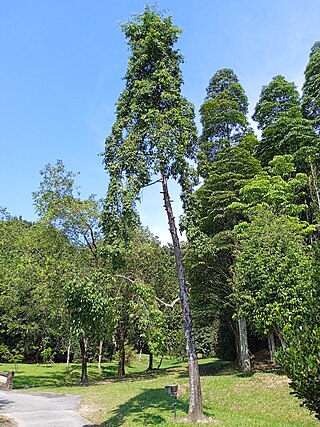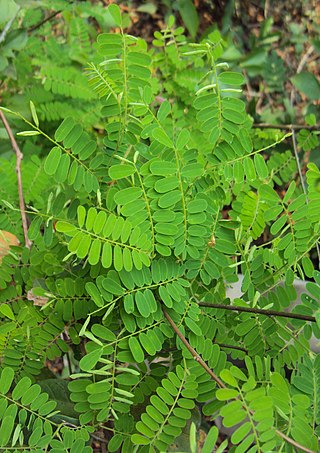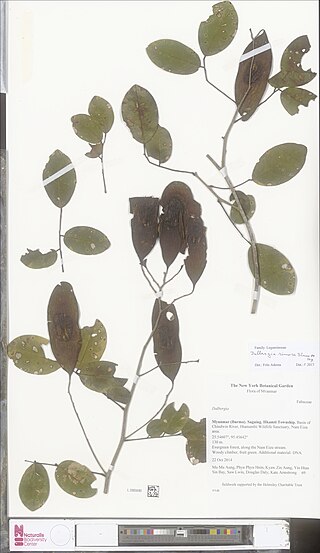Dalbergia baronii is a species of flowering plant in the legume family Fabaceae. It is endemic to Madagascar. It is named after the English missionary and botanist Rev. Richard Baron.
Dalbergia entadoides is a species of liana, found in Cambodia, Laos, Thailand and Vietnam: with the Vietnamese name trắc bàm. The genus Dalbergia is placed in the subfamily Faboideae and tribe Dalbergieae; no subspecies are listed in the Catalogue of Life.
Dalbergia monticola is a species of flowering plant in the legume family Fabaceae. It is endemic to Madagascar. It occurs at higher elevation, which gave the species its name.

Dalbergia oliveri is a species of legume in the family Fabaceae which grows in tree form to 15 – 30 meters in height. The fruit is a green pod containing one to two seeds which turn brown to black when ripe. It is threatened by habitat loss and over-harvesting for its valuable red "rosewood" timber.

Aglaia edulis is a tree species of plant in the family Meliaceae. It occurs in Tropical Asia from India to Yunnan and South-Central China. The wood and timber are used for various purposes.

Anisoptera costata is an endangered species of plant in the family Dipterocarpaceae. The specific epithet costata means "ribbed", referring to the prominent venation of the leaf blade. A huge emergent tree up to 65 m high, it is found in evergreen and semi-evergreen lowland tropical seasonal forests of Indo-Burma and in mixed dipterocarp forests of Malesia.

Halesia carolina, commonly called Carolina silverbells or little silverbells, is a species of flowering plant in the family Styracaceae, native to the southeastern United States.

Bruguiera parviflora is a tree in the family Rhizophoraceae. The specific epithet parviflora is from the Latin meaning "small flowers".

Dalbergia lanceolaria is a species of tree in the subfamily Faboideae and tribe Dalbergieae. It is a medium-sized tree growing to 20m tall and is native to: India, Sri Lanka, Nepal, Burma and Indo-China.

Terminalia phillyreifolia is an Asian species of tree in the family Combretaceae. It has been called buttontree or yon. It is a medium-sized tree found in both primary and secondary tropical and sub-tropical forests. It is recorded from India to China, south to Thailand and Vietnam. It may be one of the dominant species of deciduous forests of Vietnam. In Yunnan it is found in rocky limestone areas, near sea level to 700 m (2,300 ft).

Garcinia nigrolineata has been called "wild beaked Kandis" and is a tree species in the family Clusiaceae. The Catalogue of Life lists no subspecies.

Dalbergia horrida is a species of thorny liana, with the Vietnamese name trắc nhiều hoa which is in the subfamily Faboideae and tribe Dalbergieae.
Dalbergia candenatensis is a species of liana, with the Vietnamese name trắc một hột. It is now placed in the subfamily Faboideae and tribe Dalbergieae; no subspecies are listed in the Catalogue of Life.
Dalbergia junghuhnii is a species of shrub placed in the subfamily Faboideae and tribe Dalbergieae; no subspecies are listed in the Catalogue of Life.
Dalbergia hancei is a species of liana, with the Vietnamese name (dây) trắc Hance. The genus Dalbergia is placed in the subfamily Faboideae and tribe Dalbergieae; no subspecies are listed in the Catalogue of Life.
Dalbergia spinosa is a species of thorny liana, with the Vietnamese name trắc gai. The genus Dalbergia is placed in the subfamily Faboideae and tribe Dalbergieae; no subspecies are listed in the Catalogue of Life.

Dalbergia rimosa is a species of liana, with the Vietnamese name trắc giây or trắc dây. The synonym Dalbergia discolor, with the Vietnamese name trắc biến màu, is no longer recognised. The genus Dalbergia is placed in the subfamily Faboideae and tribe Dalbergieae.
Dalbergia velutina is a species of liana. The genus Dalbergia is placed in the subfamily Faboideae and tribe Dalbergieae.
Dalbergia stipulacea is a species of small tree, with the Vietnamese name trắc lá bẹ. The genus Dalbergia is placed in the subfamily Faboideae and tribe Dalbergieae.
Dalbergia yunnanensis is a plant species of the genus Dalbergia: which is placed in the subfamily Faboideae and tribe Dalbergieae.










